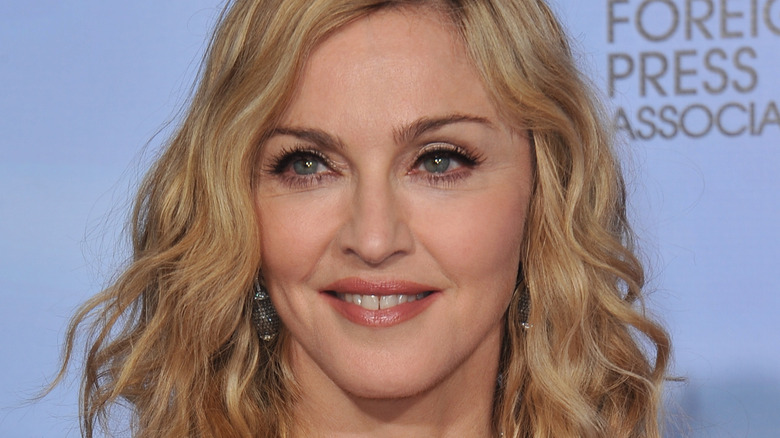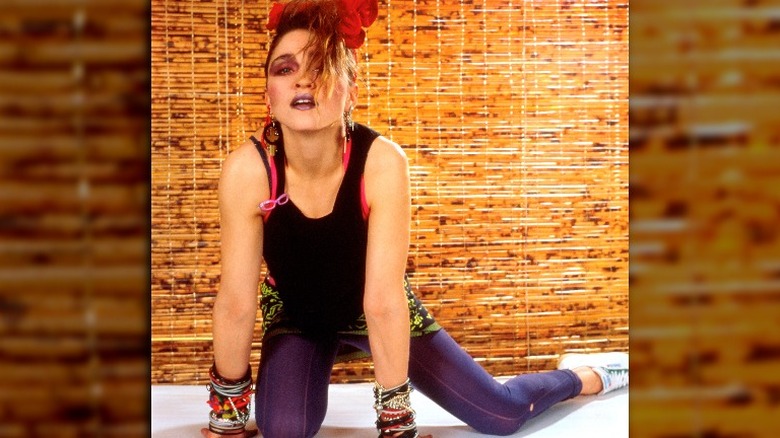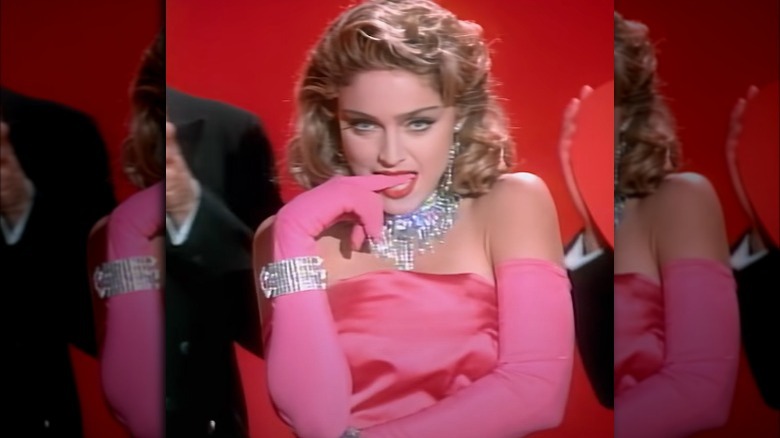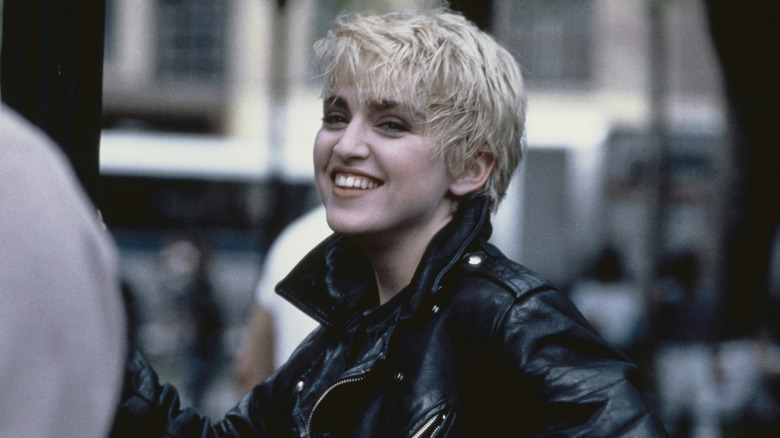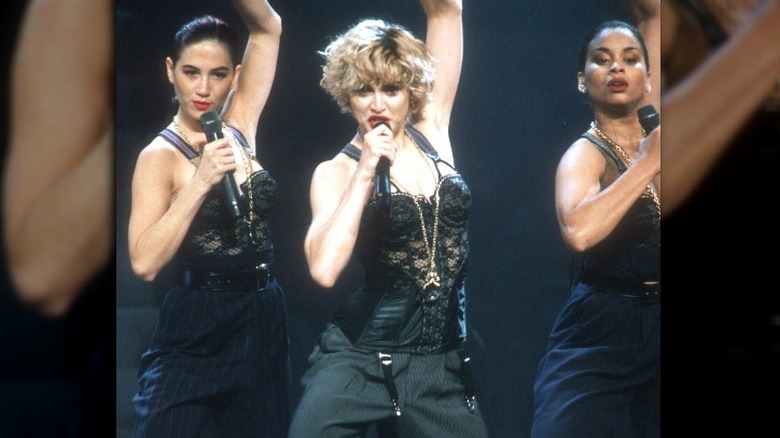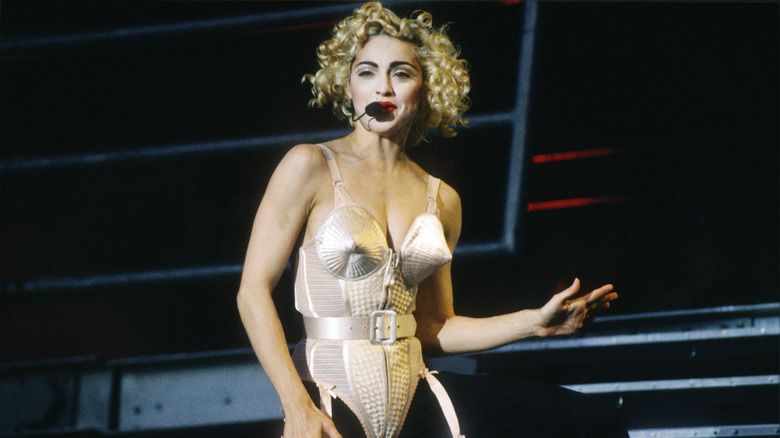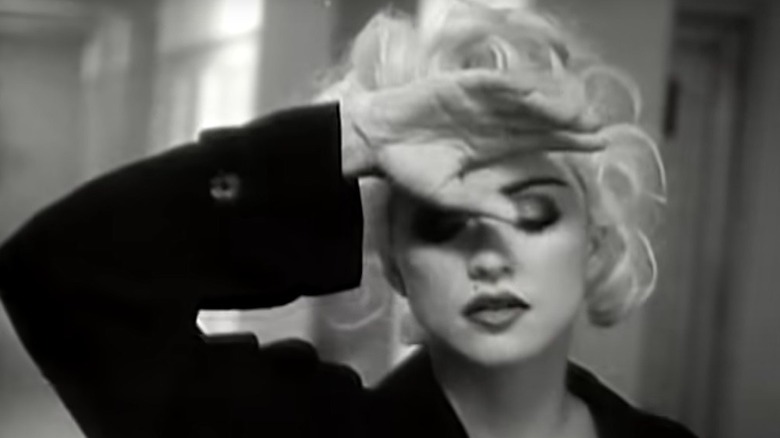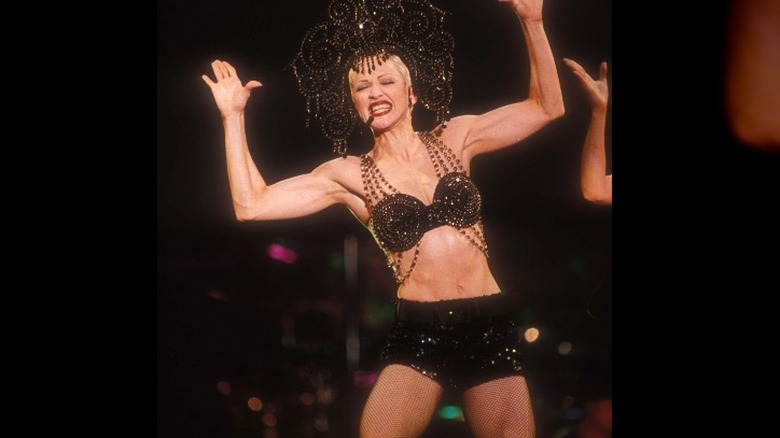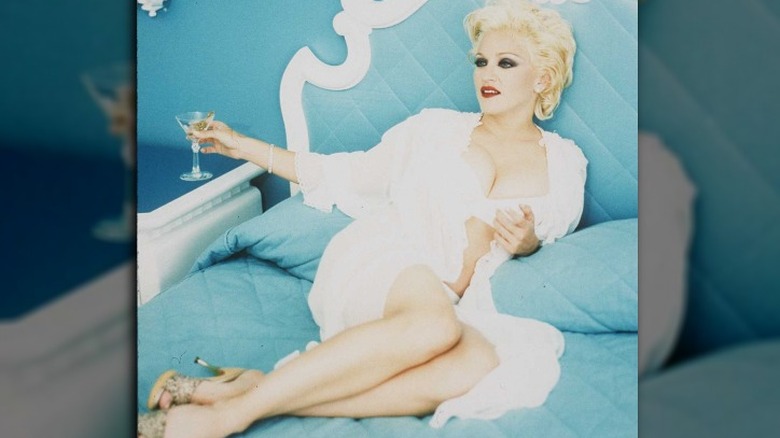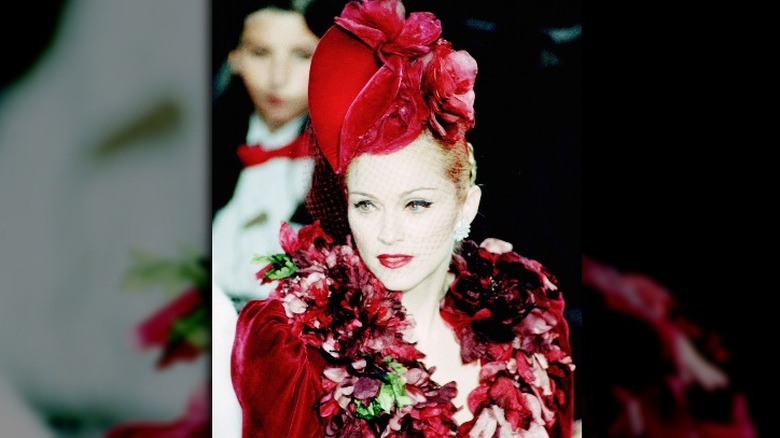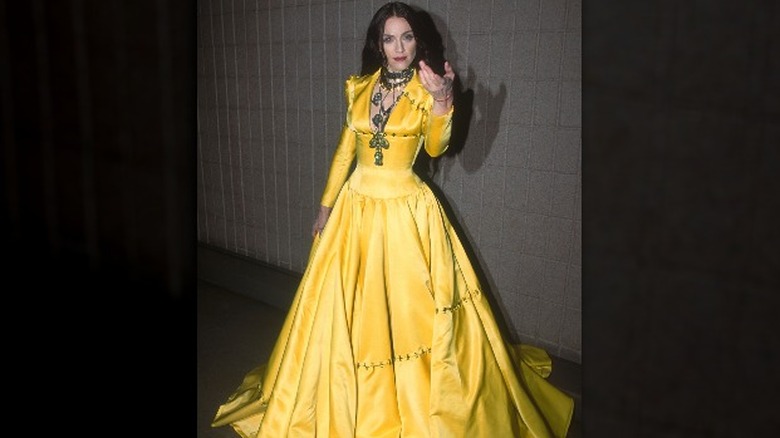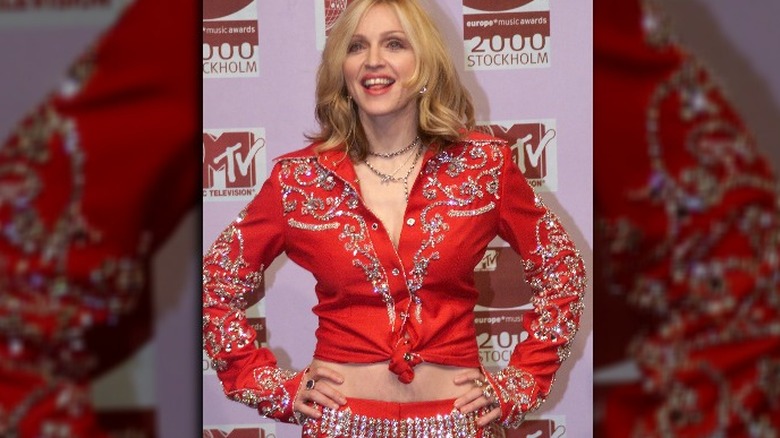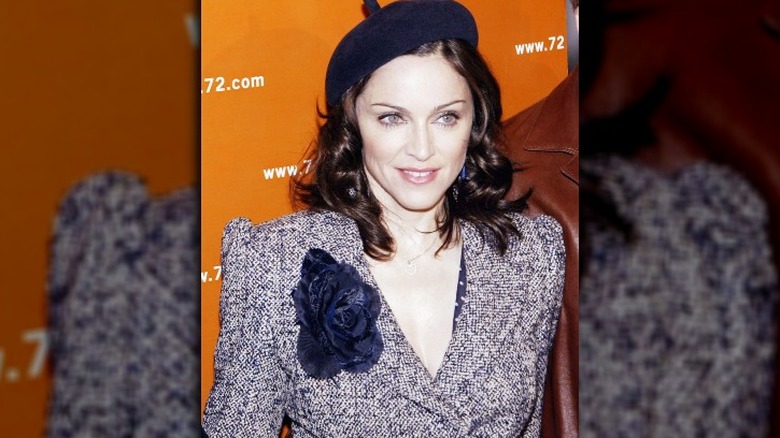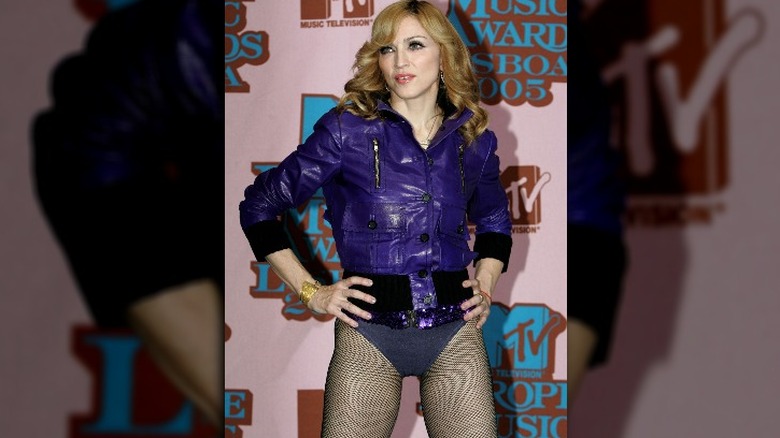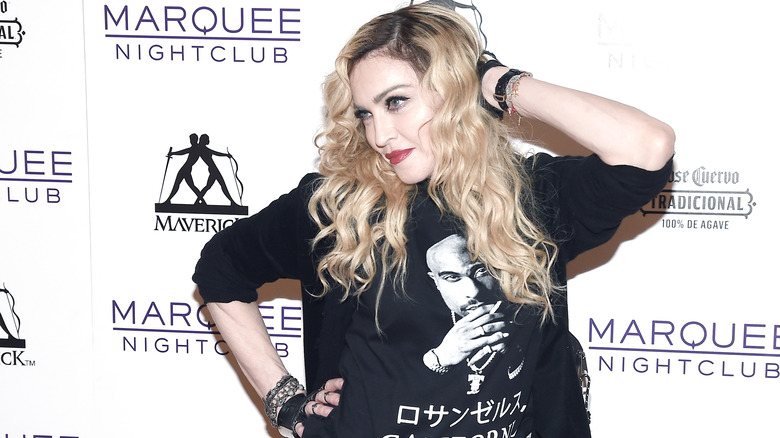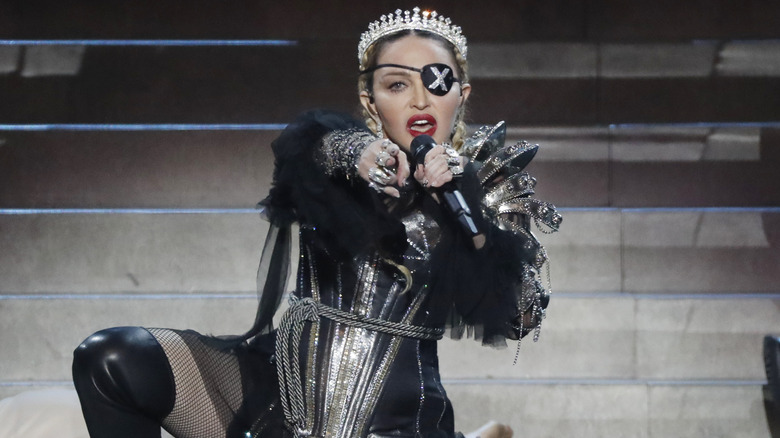The Transformation Of Madonna From 25 To 60
When Madonna first arrived in New York, she was a scrappy college dropout who decided that she'd rather pursue dance as a career here-and-now than study it in Michigan. As she once told a New York audience, her journey was "the bravest thing" she'd ever done and the first time she'd ever "taken a plane" or "gotten a taxi-cab," having arrived with just $35 in her pocket (via The Mirror). Back then, her style was confined by what she could afford to wear but her instincts for style were apparent from the get-go.
Speaking to Harper's Bazaar about the early days of her career, Madonna showcased how her fashion grew from a formative and inquisitive love of provocation. "I refused to wear makeup and tied scarves around my head like a Russian peasant," she said. "I did the opposite of what all the other girls were doing ... I dared people to like me and my nonconformity." Luckily for the queen of pop, people didn't just like her and her offbeat style — they downright loved her. So much so, that Madonna became one of the most influential fashion icons of her era — and beyond.
At every step of her evolution, Her Madgesty has broken boundaries and new ground time and again. Without further ado, here is the transformation of Madonna from her 20s to her 60s.
Madonna loudly introduces herself
With her chic punk-inspired style, tousled peroxide blonde hair with dark roots, and defiantly confident sexuality, Madonna didn't enter the music industry quietly when she dropped her first album in 1983. Her debut singles "Everybody" and "Burning Up" both peaked at respectable number three slots on the Billboard Hot Dance Club Songs chart, and it was clear that a new and exciting superstar had announced herself.
Speaking to Spin in 1985, the formative queen of pop shared a range of eclectic influences including Marilyn Monroe, Brigitte Bardot, and Nancy Sinatra — for the "go-go boots, miniskirt, blonde hair, fake eyelashes." It was also evident that her new lifestyle had an impact on her sound and fashion too, the magazine that as a result of her circumstances she "most identified" with Audrey Hepburn's "Breakfast at Tiffany's" protagonist Holly Golightly. "When I first came to New York, I was lonely, lived by myself," she said, "[I] was going to parties and not fitting in."
Golightly's sense of street chic — glamour on a shoestring — can be seen in Madonna's passion for invention during this era. But it can also be attributed to the kinetic art scene she was embroiled within. When her first album was being made she was dating the brilliant Jean-Michel Basquiat (via Artnet), and was rubbing shoulders with others like Keith Haring and Andy Warhol. "We all fed off each other's energy," she recalled to Vice, "and we were all inspired by each other and jealous of each other."
Reclaiming the blond bombshell, Madonna style
By the time of her second album, "Like a Virgin," Madonna was ready to take the foundations built with her self-titled debut and use them to forge a persona which would challenge and change culture entirely. With "Like a Virgin," Madonna wore her Catholic upbringing with pride, but not without criticism.
She slyly played with Catholic imagery and how the religion conflicted with who she was as a young woman. "I grew up with two images of a woman: the virgin and the whore," she told People in 1985. "It was a little scary." On the album's cover and subsequent music video for "Like a Virgin," Madonna juxtaposed a crisp white wedding dress with a belt buckle that stated "Boy Toy." It was a look that sexily teased innocence whilst also destroying it. She was defying the traditional confines of a sex symbol: Madonna was nobody's object.
It was a confrontational look that tied into the "Gentlemen Prefer Blondes" inspired music video for "Material Girl" — a song about favouring financial security over romance — where Madonna offered a perfect mimicry of Marilyn Monroe's performance of "Diamonds Are a Girl's Best Friend" with one crucial twist. As feminist writer Gloria Steinem mused on Madonna's imitation of the Hollywood superstar, she'd updated the look by removing Monroe's vulnerability. "Instead of using seduction to offer men whatever they want," Steinem wrote (via PBS), "Madonna uses it to get what she wants."
Madonna's Joan of Arc crop
With "True Blue," Madonna continued to explore her sexuality alongside the traditions of her Catholic upbringing with a softer approach. She also seemed eager to offer a more romantic, naive sound which delved into the pains of growing up: Gone were the rumpled sex-hair looks of her first two albums, and in their place was a blonde crop which felt as youthful as it did modest.
Just a year earlier, Madonna told Spin that though she wanted to look like a blonde bombshell "like Brigitte Bardot" that she also wanted "to look like Jean Seberg in 'Joan of Arc'" — who iconically wore a similarly cropped blonde look to depict the Catholic martyr. She explained that her upbringing played a major part in that. "I was religious, in a passionate, adolescent way," she said, "Jesus Christ was like a movie star, my favorite idol of all."
While "Like a Virgin" wryly celebrated the joys of breaking chastity, "Papa Don't Preach" delved into the subject of teenage pregnancy. In classic Madonna style, the song attracted criticism for what some groups perceived as promoting premarital sex and premarital motherhood. Speaking to The New York Times, Madonna said it was inevitable that people would take the song the wrong way, but she was having none of it. "It's a celebration of life," she explained. "It says, 'I love you, father, and I love this man and this child that is growing inside me.'"
The sinful lingerie looks of Madonna
With "Like a Prayer," her fourth studio release, Madonna made her most intimate and personal album to date. The performer told Yahoo! Entertainment that she found herself in a dark, lonely, and isolated place when developing the collection of songs, which she described as "a real coming-of-age record" that took "a lot of soul-searching" to make. She also suggested it was inspired by her "bonds with her family." For the album's launch, Madonna made a controversial but critically acclaimed music video for the title track.
For the video, Madonna plumped up her cleavage and danced in front of burning crucifixes in a lingerie slip once worn by the late actor Natalie Wood. As the musician's frequent costume designer Marlene Stewart told Vogue, the song and visuals were both reflections of Madonna's "cultural heritage" and the commingling of sexual and religious ecstasy. The video's look, then, was a conspicuous attempt to push back. As Stewart said, "If you follow the tenets of the religion, there is something about showing lingerie, wearing lingerie as outerwear, which is very sinful in some way."
Madonna's drastic switch from blond to brunette was also loaded with personal symbolism for the star. "I feel more grounded when I have dark hair, and I feel more ethereal when I have light hair," she said in Rolling Stone. "It's unexplainable. I also feel more Italian when my hair is dark."
Madonna ruffles feathers with her stage show
Madonna first dabbled with the power pairing of feminine corsetry with masculine tailoring in the David Fincher-directed video for "Express Yourself." But for 1990's "The Blond Ambition Tour," she really upped the ante when she collaborated with Jean Paul Gaultier on what would become one of her most defining and influential looks: the cone bra and pinstripe suit.
As Vogue once described the look, this new imagining of the corset reshaped the "soft curves" of female anatomy to become "a spiky, phallic weapon" full of dominance. It made a statement, to say the least. And it was the perfect ensemble to accompany a live show that Catholic organizations threatened to ban Madonna from Italy, accusing it of "overflowing with vulgarity and blasphemy," per the Los Angeles Times.
The salacious stage show had caused a lot of pearl clutching, including an incident in Canada where she almost got arrested for pantomiming masturbation on stage, per Billboard. But this was a woman who once insisted to The New York Times that "art should be controversial," and she wouldn't have her self-expression muted for anyone or anything. "My show is not a conventional rock concert but a theatrical presentation of my music," she told reporters. "It poses questions, provokes thought and takes you on an emotional journey. ... I do not endorse a way of life but describe one."
Madonna's multiverse of characters
By the early '90s, Madonna had become acclimated to the constant public criticism of her persona and performance style. Many judgments hurled against her often confused what she intended as artistic expression as instead being a form of personal exhibitionism. Clearly reflecting on these ideas, Madonna entered an era of exploration between the boundaries of performance and reality.
"Truth or Dare," a documentary following the hysterical bombast of the star's "Blond Ambition Tour," seemingly granted access to all areas of Madonna's private and professional life, but with questionable authenticity. As The Guardian touched on the different versions of Madonna in the doc, authenticity wasn't really the point — the play on personas was: "The real Madonna was the constructed one, and vice versa."
In 1991, she'd once again slipped back into the comforts of Marilyn Monroe cosplay, including a stunning Bob Mackie look at the Academy Awards which she paired with $20 million worth of diamonds with an Oscar win for the "Dick Tracy" track "Sooner or Later" (via CR Fashion). Furthermore, in the banned music video for "Justify My Love," Madonna made love and roamed corridors looking like a young woman possessed by Monroe's seductive ghost. When "Nightline" accused her of "pushing the limits" of what is "permissible" to be seen on TV and of peddling pornography under the guise of "art," she responded, "I draw the line with violence and humiliation and degradation, okay?" She was only getting started.
Madonna continues to push the envelope
Once she'd discovered that she'd hit a certain cultural nerve, Madonna continued to delight in digging her nails in with her most provocative works yet. The star achieved a double whammy of sexual incitement with the release of album "Erotica," and "Sex" — her book of photography which served up softcore pornography through a post-feminist lens. In both "Sex" and "Erotica" Madonna explored the outer reaches of human sexuality via a dominatrix alter ego named Dita.
As Billboard once wrote of "Erotica," the album set "the blueprint" for singers to "get raw while eschewing exploitation" and with both works she wasn't just challenging the male gaze, but "making the world her sub." Sadly, not everyone agreed and both were met with backlash. For The Guardian, Martin Amis called "Sex" "the desperate confection of an ageing scandal-addict" while Spin called the book "a con job" for teasing titillation whilst serving up "pretentious" art. But perhaps arousal wasn't the point? Madonna told the magazine that she was trying to make a simple point: "Why should we feel ashamed of our sexuality?"
Unsurprisingly, Madonna's sense of style became even more stripped-down during this period, and especially so for "The Girlie Show Tour" which followed. Her "Joan of Arc" cropped hair made a return which called to mind the idea of being burned at the stake.
Madonna puts the bad girl to bed
The woman who once told Spin that "Erotica" and "Sex" were the result of living "in a very repressed society" returned to music with "Bedtime Stories," a relatively repressed offering from the provocateur. Society had given pop's bad girl a spanking and for the first ever, Madonna yielded rather than push back. The result? A soft, slumber party of an album which occasionally tip-toed back into the dark closet where Madonna had hung up her former dominatrix persona.
Songs like the Björk penned "Bedtime Story" and the seductively dark "Secret" take Madonna into dawdling electronic dream states which feel fresh for the singer. But "Human Nature" — a song featuring the line "You punished me for telling you my fantasies" — suggests that though Madonna was willing to tone things down, she wasn't about to apologise for her behaviour. "It's quite obvious I'm addressing the public," she said of the song in a 1994 interview with Q Magazine (via Paul Dunoyer). "[It's saying] Hey, get offa my back; don't hang all of your hang-ups on me."
Defiant, she clad herself in PVC for the music video, and playfully performed a parody of BDSM acts with her dancers. But that aside, the star's overall look had softened. In the album's promotional images, the star wears white in a wry performance of virtue, and rocks dark, heavy makeup evocative of the grungy porcelain doll style of alternative rock bands like Babes in Toyland and Hole.
The silver screen calls to Madonna time and time again
By 1996, Madonna had left behind the chaste performance and femme fury of "Bedtime Stories" to delve back into her cosplay closet. This time, however, she wasn't mimicking Marilyn Monroe but Eva Perón, the legendary political figure and former first lady of Argentina.
Madonna had already nabbed a few credits before she scored the titular role in the musical drama "Evita." She'd gained desperately mixed reviews from starring in a slew of movies including "Desperately Seeking Susan," "Body of Evidence," "Dick Tracy," and "A League of Their Own." The latter of which caused legendary actor Debra Winger to quit when Madonna was cast. Of the music superstar's onscreen skills, she sniped to The Telegraph, "I think her acting career has spoken for itself." Regardless, Madonna was determined to be taken seriously as an actor, and "Evita" was her vehicle to do so.
Madge had "always insisted" she was the best choice for the role, and she told Roger Ebert that she "was possessed" by Perón during filming. When trying to convince the Argentine president to allow them to film in iconic political locations for the film, Madonna said she "went in costume to the meeting." She also maintained this look for most red carpet appearances that followed. She was no longer Madonna, the renegade pop star — she was Madonna, the first lady of Hollywood.
Madonna's introspective, spiritual phase
With the birth of Lourdes Leon, her first child, Madonna found herself discovering new perspectives — and Kabbalah (via The Times) – and it came through in her cutting-edge, spiritual pop opus "Ray of Light." The star told Q Magazine (via Digital Spy) that the arrival of her daughter "was a big catalyst" for the left field electronica album. "It took me on a search for answers to questions I'd never asked myself before," she shared.
True to form, Madonna returned to her Italian roots and experimented with dark hair again for the first major time in her career since "Like a Virgin." She also delved into the duality of her everyday existence: On the one hand, she could be casual in double denim, her blonde hair hanging loose and natural, as in the video for "Ray of Light." On another, she could be conjuring crows in the desert with all the gothic zeal of Moira Rose, in a full Jean Paul Gaultier black gown for the "Frozen" video. Motherhood had brought her back down to earth, but she was still asking big things of herself and the universe.
Aesthetically, that translated to an intangible elegance that was as ethereal as it was jagged, such as the corseted yellow Olivier Theyskens gown Madonna wore for the VH1 Fashion Awards in 1998. Madonna looked like a witch that the world had tried, and failed, to burn. And here she was looking more fabulous than ever.
An American pop star in London
Madonna met "Lock Stock and Two Smoking Barrels" filmmaker Guy Ritchie in 1999 and the two promptly fell in love and had gotten married and welcomed their first child together just a year later (via The Mirror). The queen of pop left the US for Britain to be with her new fella, and the distance from her home country allowed her to develop a new ironic sense of style which felt parodic of herself and of American culture.
"Music," her eighth studio album, played around with this idea. And though it was riffing on pre-existing musical tropes, the album's genre-jumping electronica was firmly looking forward with Madonna once describing it as "the future as sound" (via Digital Spy). For the primary promotion of "Music" Madonna wore an endless supply of glitzy cowboy clobber which celebrated American identity with a garish sense of wit.
Her tongue-in-cheek ironic style experiments continued on the red carpet with her new hubby. Ritchie and Madonna would delight in wearing matching his-and-hers ensembles which often made the two look like a pair of superstar, Vegas newlyweds. Be it the "Snatch" and "Music" t-shirts they wore promoting each other's respective new releases, or the diamanté "Mrs Ritchie" encrusted bridal suit Madonna wore to the "Snatch" premiere (via Go Fug Yourself), the lovebirds toyed with the tastefulness of self-promotion and pushed it new, joyfully tacky extremes.
Madonna's 'political' and 'thoughtful mood'
After almost five years in the UK, Madonna reached an Anglophile apex, and could regularly be seen out and about in traditional British regalia like tweed suits, floral tea dresses, and an occasional British accent which she'd later tell a London audience she was "horrified and flabbergasted" by (via BBC). Looking at America from the other side of the Atlantic, Madonna found herself critical of her home country and her place within it, using lead track "American Life" to question a "type of modern life." When asked about the lyrics on "Dateline," she said the song was about "trying on so many different guises" in a bid to get approval and "be on the top."
When she wasn't wearing outfits that screamed "afternoon tea?," Madonna appeared dressed like she was ready for a musical coup, pairing military fatigues with berets. Speaking to The Guardian, she described how she got sucked into a "French existential vortex" while making the album, and how feeling "against everything" inspired her style. "I was in a very thoughtful mood," she said. "A very angry mood, a mood to be political, [and] upset with George Bush."
Though she was open with her concerns about US politics and the Iraq War, she ultimately pulled her initial anti-war video for "American Life" due to her feeling it was inappropriate to share while soldiers were dying in battle. As she said on "Dateline," "I don't want to just be provocative for the sake of being provocative." Madonna had grown.
Taking it to the dance floor with Madonna
Next, Madonna swapped out the military fatigues for leotards and fishnet tights. New York City's former dancing queen was back in a big way, and with 2005's "Confessions of a Dance Floor" she just wanted to spread some joy. Stating that she was "very agitated" by global events when she wrote "American Life," she told MTV that she wanted "to feel buoyant" and make something she could dance to. "I want to give other people the same feeling," she said, "There's a lot of madness in the world around us, and I want people to be happy."
The result was an album that gleefully reminded listeners of the safety and jubilance of the dance floor: Even if the world is terrible, you can always dissolve your worries into disco. It was a sound and look which worked for the star, who continued to find solace in the liberating dance vibes of her youth for her next album "Hard Candy."
For the 2008 release, Madonna collaborated with, as Pitchfork wrote, "American men [who'd] come to define global pop." She teamed up with the Neptunes, Kanye West, and Justin Timberlake, giving her sound a polished, contemporary sound. But she also never let her collaborators forget she was the champ, and for "Hard Candy" her dance ensemble had confidently morphed into a slick boxing leotard, complete with a championship belt, presenting a proud feminine toughness: The sweetness of dance, and also the fortitude of it.
Madonna reminds the world of who she is
Not long after the release of "Hard Candy," Madonna went through a public divorce from Guy Ritchie. Four years later, she released "MDNA," an album which Rolling Stone astutely described as being a "disco-fied divorce record" and Glamour dubbed as being the explicit sound of "a woman trying to make sense of her marriage ending."
The album artwork has a close-up of the star's partially obscured face behind a prism, as though she was lost within the spectrum of her various personas. It was oddly symbolic for a moment where the star lacked a singular knockout look to accompany the album as usual. Instead, she appeared to be a woman in crisis — struggling to reclaim her identity in the post-breakup grief. But with her next album "Rebel Heart," she remembered exactly who she was with a single which confidently declared, "B**ch I'm Madonna."
For the music video, the icon was shown partying in a sartorial greatest hits remix of her best looks. Grand and celebratory, she paired self-referencing items like the "Boy" belt buckle that nods to her "Boy Toy" waist of her "Like a Virgin" days, and a pair of fingerless gloves that throwback to her '80s signature style. A Tom Tom Fashions t-shirt boldly printed with a still of her own face from the "Vogue" music video sealed the deal: The rebel had found herself again.
The many sides of Madonna's Madame X
After boldly stepping back into her public persona with "Rebel Heart," Madonna decided to don an eyepatch and go undercover in her own career with the release of 2019's "Madame X." In signature Madge style, the album, which came out just before her 61st birthday, was personal and fictional all at once, with the star developing an alter-ego that she could slip into while exploring ideas close to heart.
Speaking to "Today," Madonna described Madame X as being a global "secret agent" who "changes her identity" often. The character was inspired by the nickname her former dance teacher gave her due to her mysterious, impenetrable nature — "she could never 'identify' who Madonna was" – - a problem that the star similarly had with herself while recording. "I felt the same way," she said, "I had to create a story that was sort of the beginning of Madame X's journey."
Aesthetically, Madonna took the "greatest hits" element of her "Rebel Heart" look and intensified it within the lens of a narrative. Madame X wasn't Madonna, but an extension of her; in the album's teaser trailer, she described the character as "a dancer, a professor, a head of state ... a mother, a child, a teacher, a nun, a singer, a saint, a whore." She subsequently bound between cowboy hats and tailored suits, bridal gowns and silk floral dresses. All looks that had come to signify Madonna over the years, which were now decontextualized within a new narrative — and, as ever, blurring the boundaries between reality and performance.

